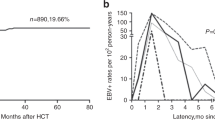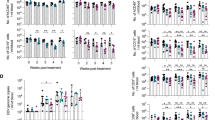Abstract
There is a growing interest in the evaluation of non-myeloablative conditioning therapy for allogeneic stem cell transplantation. Such regimens are expected to produce less toxicity while allowing both engraftment and a graft-versus-disease effect from the large number of donor-derived immunocompetent T lymphocytes given with the stem cells. Heavy immunosuppression used in recipients may have unexpected consequences. We describe the occurrence of a fatal Epstein–Barr virus-associated B cell lymphoproliferative disease (BLPD) early after such a non-myeloablated allogeneic peripheral blood stem cell transplant in a heavily pre-treated patient.
This is a preview of subscription content, access via your institution
Access options
Subscribe to this journal
Receive 12 print issues and online access
$259.00 per year
only $21.58 per issue
Buy this article
- Purchase on Springer Link
- Instant access to full article PDF
Prices may be subject to local taxes which are calculated during checkout
Similar content being viewed by others
Author information
Authors and Affiliations
Rights and permissions
About this article
Cite this article
Milpied, N., Coste-Burel, M., Accard, F. et al. Epstein–Barr virus-associated B cell lymphoproliferative disease after non-myeloablative allogeneic stem cell transplantation. Bone Marrow Transplant 23, 629–630 (1999). https://doi.org/10.1038/sj.bmt.1701628
Received:
Accepted:
Published:
Issue Date:
DOI: https://doi.org/10.1038/sj.bmt.1701628
Keywords
This article is cited by
-
Risks and Mechanisms of Oncological Disease Following Stem Cell Transplantation
Stem Cell Reviews and Reports (2010)
-
Fatal EBV-related post-transplant lymphoproliferative disorder (LPD) after matched related donor nonmyeloablative peripheral blood progenitor cell transplant
Bone Marrow Transplantation (2003)
-
Fatal donor-derived Epstein–Barr virus-associated post-transplant lymphoproliferative disorder following reduced intensity volunteer-unrelated bone marrow transplant for myelodysplastic syndrome
Bone Marrow Transplantation (2002)



